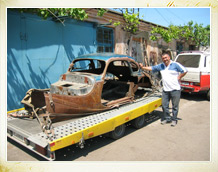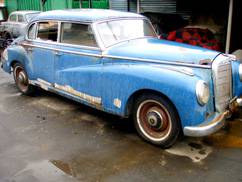Mercedes-Benz first unveiled the W186, 300 series sedan (no letter designation) and cabriolet 4-door model at the 1951 Paris exhibition auto show. It's unique appearance and features, in comparison to previous post war models, were a huge success, gaining instant appeal by State governments, celebrities, and wealthy businessmen. Features included the X frame chassis of prior models, a 6 cylinder overhead valve carburated engine to compensate for 2+1/2 ton weight, central lubrication system of the 170 model, swing axle, and rear load leveler.
Unique options included, several Becker radio models, VHF short-waved telephone, dictation machine, 7 basic MB colors, Webasto and metal sunroof, and a custom-ordered combination of wood trim types, leather or cloth seats, and carpeting. The models used by Dr. Konrad Adenauer had further custom features including window curtains, divider window, magazine/newspaper nets, writing/eating trays, document storage, lighted mirrors, fog lamps, sirens, and flag holders.




























































































































